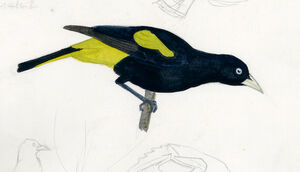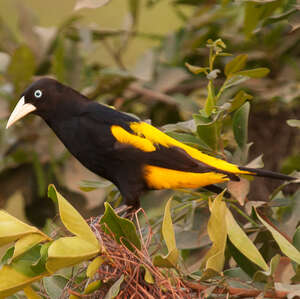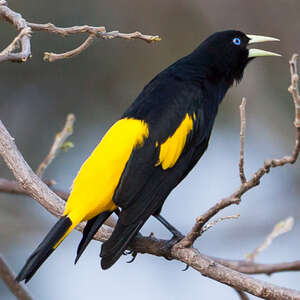Yellow-rumped Cacique
Cacicus cela - Cassique cul-jaune
Identification
The Yellow-rumped Cacique - what a funny name for a bird! Its name probably comes from the Indian Cacique, akin to a village chief. This name, as it was 'Hispanized' now describes a notable important in the community. Our bird is also a subject of stories in Peruvian folklore; called Paucar, it was supposedly a young man who always wore a black trousers with a yellow jacket. One day, this man accused an old woman who was actually a fairy in disguise; the fairy then took her revenge by turning the man into a noisy wandering bird. It should be noted that our cacique is presumed to be a bird of good omen!
A large passereau (a large passerine bird), with the male measuring 28 cm. The dominant colour is a slightly glossy black, visually striking with its bright yellow markings on its greater and median coverts. These markings vary between individuals and the subspecies; ssp presents a much more yellow colouration on all of its coverts, while ssp vittelinus has its yellow marking mostly restricted to its greater coverts. A yellow colour also appears on other parts of the bird, such as its lower belly, rumps and undertail coverts, making the Yellow-rumped Cacique unmistakable and giving certainty of its identification. Its tail feathers are black and its tarsi (tarsometatarsus) are clad in the same black plumage, with steel-grey coloured tarsi. Its beak is ivory-white, almost cream, long and strong at the base, giving the Yellow-rumped Cacique a sometimes unfriendly appearance. Its pupil is black, with a sky blue eye-ring around it highly visible.
There is little difference between the sexes; females, in general, have a duller yellow colour. The young do not have their parents' sky blue eye ring.
Subspecific information 3 subspecies
- Cacicus cela cela (e Colombia and Venezuela, the Guianas south to c Bolivia and s Brazil)
- Cacicus cela vitellinus (c Panama to n and c Colombia)
- Cacicus cela flavicrissus (w Ecuador and nw Peru)
Foreign names
- Cassique cul-jaune,
- Cacique lomiamarillo,
- xexéu,
- Gelbbürzelkassike,
- sárgafarkú kacika,
- Geelstuitbuidelspreeuw,
- Cacicco groppagialla,
- gulgumpad kasik,
- Gulgumpkasik,
- trupiál žltochrbtý,
- vlhovec žlutokostřecový,
- Gulgumpet Pungstær,
- kultaperäkasikki,
- cacic sedós,
- kacykowiec żółtosterny,
- Желтопоясничный чёрный кассик,
- キゴシツリスドリ,
- 黄腰酋长鹂,
- gulgumpad kasik,
- 黃腰酋長鳥,
Voice song and call
The Yellow-rumped Cacique is a very talkative bird. Its usual call is a repeated kweu which changes into a short and shrill kwawk when alarmed; in Surinam, it has been observed to sing different songs depending on the time of day; males of the vitellinus subspecies can also sing very high verses, as well as short and deep twittering. The Yellow-rumped Cacique is mainly a gifted imitator: parrots, woodpeckers, passerines, it can even imitate mammals.
Habitat
You can find it everywhere, from sparse forests to dense ones, savannas, prairies with large trees, along the major rivers of northern South America. It can reside in the flooded sections, called varzea along the Amazon and also go deep inside the Amazon jungle. It is called the Yellow-rumped Cacique.
Behaviour character trait
Dietfeeding habits
Reproduction nesting
Yellow-rumped Caciques can reproduce year-round, with variations depending on the region: April-May in Panama, November-January in Brazil, June-September in Bolivia, and practically all year round in Suriname.
Yellow-rumped Caciques are polygamous: the male will stay with the female who will incubate 2 eggs for 15 days. The nestling period lasts from 24 to 28 days, until the time they leave the nest. The male will have several females successively, with dominant males claiming the greatest number of females (up to 27 for one male!). The nest is made solely by the female, who takes 5 to 15 days to build it with vegetal fibers and palm leaves; the male, however, will fiercely defend the nest and its progeny. The nest is pouch-shaped and 38 to 50 cm high, with the opening at the top and hanging from a branch. Nesting in colonies, there can be up to a hundred nests in one colony, often in company with Cacicus haemorrhous, the red-rumped Cacique, in order to strengthen colony defense. Observers often noticed that nests of aggressive wasps such as Synoeca or Polybia were situated near Yellow-rumped Cacique nests in order to form a barrier against predators. The bird also uses natural or human-made barriers; the colonies are situated on small islands or isolated trees in the middle of a river or Amazonian varzea, even close to villages. Although colonies can reinforce defense, they attract many predators that look for eggs or nestlings, such as monkeys, birds of prey (like caracaras), and snakes.Geographic range
From Central America, Panama, the northern part of South America, Ecuador, Colombia, the north-western part of Peru, Venezuela, Bolivia and of course Brazil, where it can be seen both in the Amazon jungle and in Mato Grosso; large populations of the Yellow-rumped Cacique are present on the east coast of Brazil.
Threats - protection
IUCN conservation status
concern
in the Wild
threatened
evaluated
The Yellow-rumped Cacique poses no concern at this time. It is worth noting the important role of the ssp vitellinus in pollinating the bacuri, Platonia esculenta, whose wood is sought out for construction; its fruit, rich in vitamin C, is either eaten or used to make alcohol. The seeds can also be used to treat skin diseases.
Sources of information
- IOC World Bird List (v15.1), Gill, F and D Donsker (Eds). 2025-12-07.
- A Field Guide to the Birds of Brazil, Ber Van Perlo
- Birds of Peru, Thomas S.Schulenberg, Douglas F.Stotz, Daniel F.Lane, John P.O'Neill, Theodore A.Parker III
- Handbook of the Birds of the World Vol 16, Josep del Hoyo, Andrew Elliott, David Christie
- ARKive, Christopher Parsons
- Arthur Grosset's Birds, Arthur Grosset
- Neotropical Birds Online,
- Wikipédia, Wikipedia, The Free Encyclopedia
Other sources of interest
 Specification sheet created on
30/07/2023 by Anne et Gabriel Leboff
Specification sheet created on
30/07/2023 by Anne et Gabriel LeboffTranslation by AI Oiseaux.net
© 1996-2025 Oiseaux.net
- Accipitriformes
- Aegotheliformes
- Anseriformes
- Apodiformes
- Apterygiformes
- Bucerotiformes
- Caprimulgiformes
- Cariamiformes
- Casuariiformes
- Charadriiformes
- Ciconiiformes
- Coliiformes
- Columbiformes
- Coraciiformes
- Cuculiformes
- Eurypygiformes
- Falconiformes
- Galliformes
- Gaviiformes
- Gruiformes
- Leptosomiformes
- Mesitornithiformes
- Musophagiformes
- Nyctibiiformes
- Opisthocomiformes
- Otidiformes
- Passeriformes
- Pelecaniformes
- Phaethontiformes
- Phoenicopteriformes
- Piciformes
- Podargiformes
- Podicipediformes
- Procellariiformes
- Psittaciformes
- Pterocliformes
- Rheiformes
- Sphenisciformes
- Steatornithiformes
- Strigiformes
- Struthioniformes
- Suliformes
- Tinamiformes
- Trogoniformes































